Analyzing Australia's Stable Economic Equilibrium: A Report
VerifiedAdded on 2020/04/01
|9
|1466
|43
Report
AI Summary
This report focuses on the theory of stable economic equilibrium, explaining how external shocks are counteracted to restore the original equilibrium. It highlights both microeconomic and macroeconomic stability, using market equilibrium as an example. The report analyzes the Australian economy's current stability, examining key indicators such as GDP and inflation rates. It references data from the Australian Bureau of Statistics and the Reserve Bank of Australia to assess the country's economic performance. The report also discusses the role of the Australian government in stabilizing the economy through automatic and discretionary stabilizers. The conclusion asserts that the Australian economy is currently in a state of stable equilibrium, supported by the analysis of GDP, inflation, and government interventions.
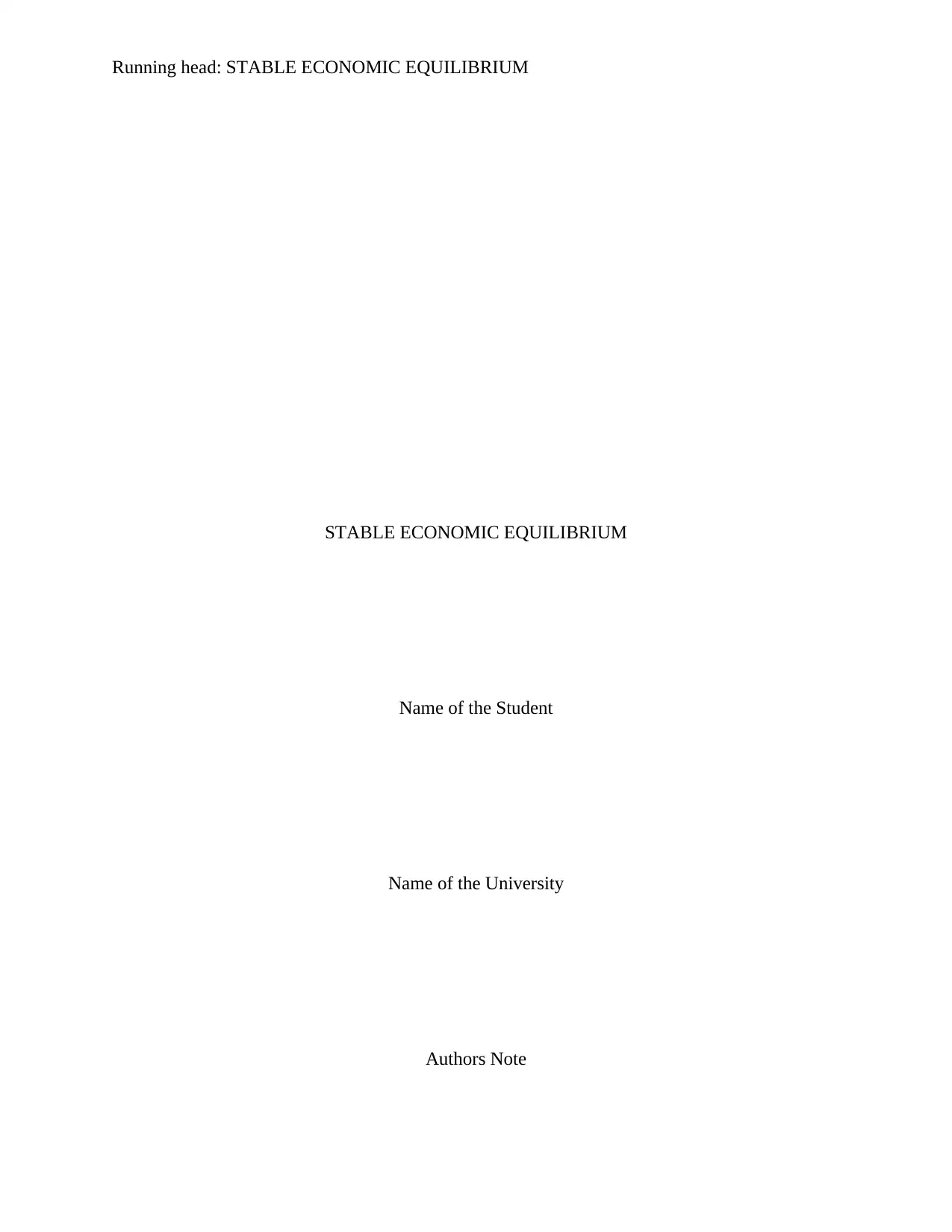
Running head: STABLE ECONOMIC EQUILIBRIUM
STABLE ECONOMIC EQUILIBRIUM
Name of the Student
Name of the University
Authors Note
STABLE ECONOMIC EQUILIBRIUM
Name of the Student
Name of the University
Authors Note
Paraphrase This Document
Need a fresh take? Get an instant paraphrase of this document with our AI Paraphraser
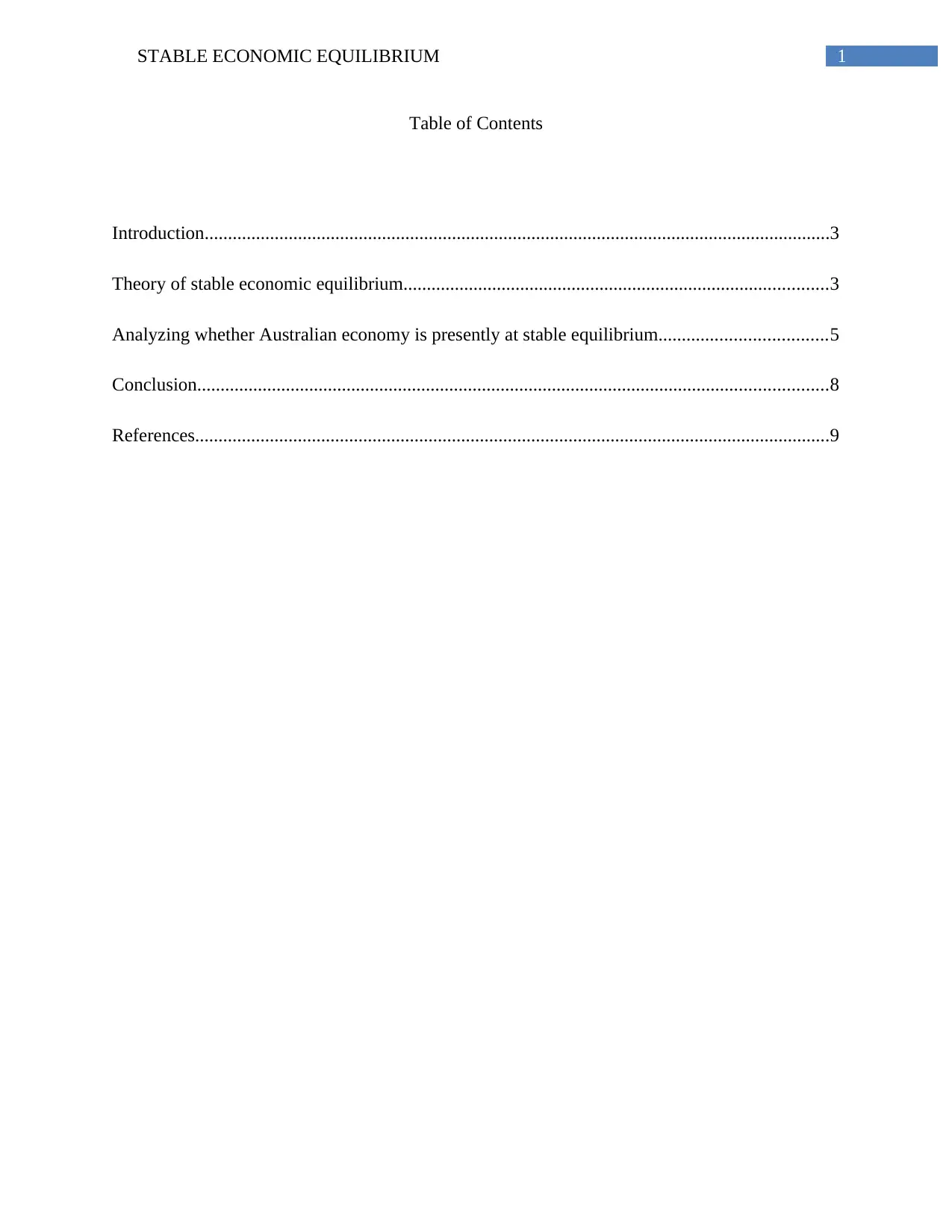
1STABLE ECONOMIC EQUILIBRIUM
Table of Contents
Introduction......................................................................................................................................3
Theory of stable economic equilibrium...........................................................................................3
Analyzing whether Australian economy is presently at stable equilibrium....................................5
Conclusion.......................................................................................................................................8
References........................................................................................................................................9
Table of Contents
Introduction......................................................................................................................................3
Theory of stable economic equilibrium...........................................................................................3
Analyzing whether Australian economy is presently at stable equilibrium....................................5
Conclusion.......................................................................................................................................8
References........................................................................................................................................9
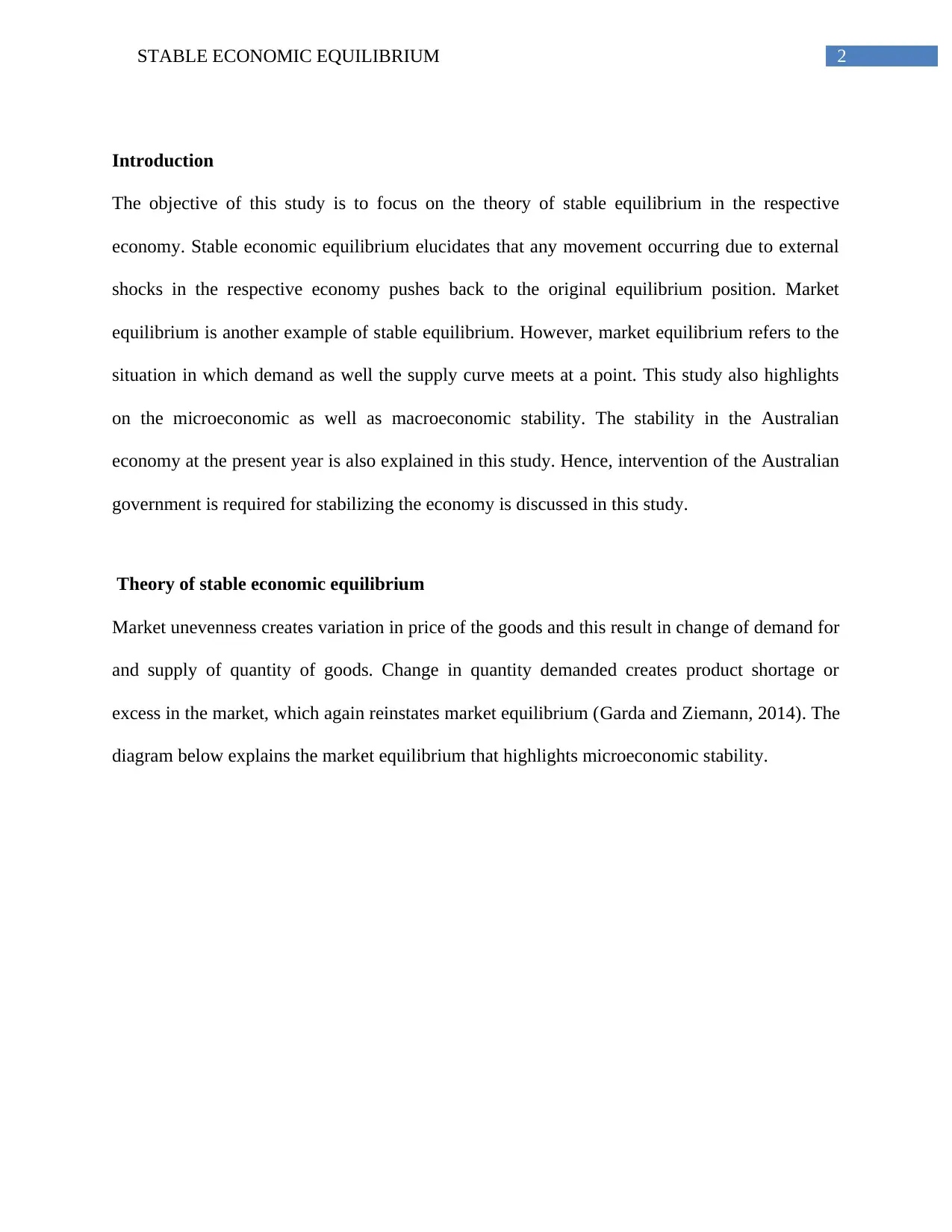
2STABLE ECONOMIC EQUILIBRIUM
Introduction
The objective of this study is to focus on the theory of stable equilibrium in the respective
economy. Stable economic equilibrium elucidates that any movement occurring due to external
shocks in the respective economy pushes back to the original equilibrium position. Market
equilibrium is another example of stable equilibrium. However, market equilibrium refers to the
situation in which demand as well the supply curve meets at a point. This study also highlights
on the microeconomic as well as macroeconomic stability. The stability in the Australian
economy at the present year is also explained in this study. Hence, intervention of the Australian
government is required for stabilizing the economy is discussed in this study.
Theory of stable economic equilibrium
Market unevenness creates variation in price of the goods and this result in change of demand for
and supply of quantity of goods. Change in quantity demanded creates product shortage or
excess in the market, which again reinstates market equilibrium (Garda and Ziemann, 2014). The
diagram below explains the market equilibrium that highlights microeconomic stability.
Introduction
The objective of this study is to focus on the theory of stable equilibrium in the respective
economy. Stable economic equilibrium elucidates that any movement occurring due to external
shocks in the respective economy pushes back to the original equilibrium position. Market
equilibrium is another example of stable equilibrium. However, market equilibrium refers to the
situation in which demand as well the supply curve meets at a point. This study also highlights
on the microeconomic as well as macroeconomic stability. The stability in the Australian
economy at the present year is also explained in this study. Hence, intervention of the Australian
government is required for stabilizing the economy is discussed in this study.
Theory of stable economic equilibrium
Market unevenness creates variation in price of the goods and this result in change of demand for
and supply of quantity of goods. Change in quantity demanded creates product shortage or
excess in the market, which again reinstates market equilibrium (Garda and Ziemann, 2014). The
diagram below explains the market equilibrium that highlights microeconomic stability.
⊘ This is a preview!⊘
Do you want full access?
Subscribe today to unlock all pages.

Trusted by 1+ million students worldwide
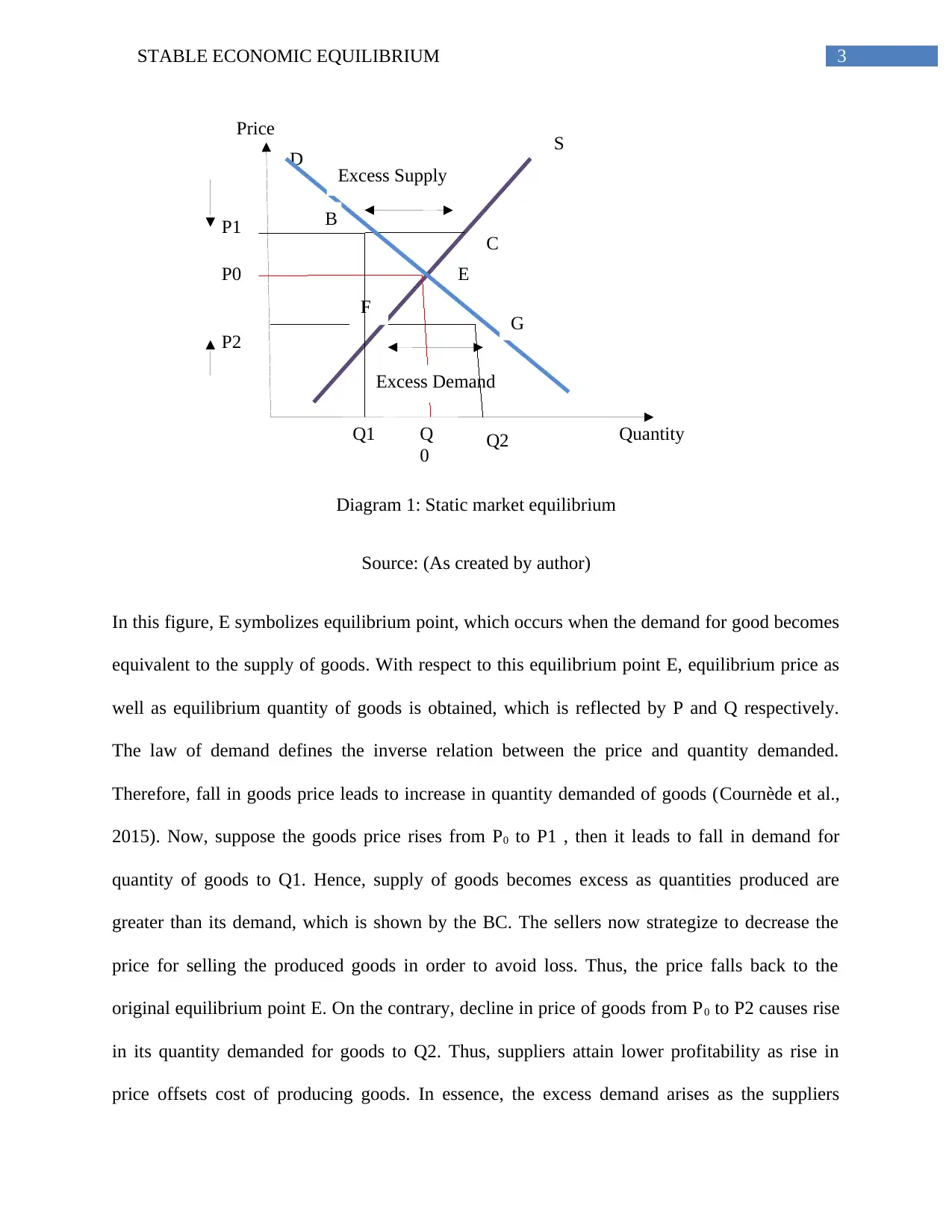
3STABLE ECONOMIC EQUILIBRIUM
S
D
E
Quantity
Price
P0
P1
P2
Q
0
Excess Supply
Excess Demand
G
F
C
B
Q1 Q2
Diagram 1: Static market equilibrium
Source: (As created by author)
In this figure, E symbolizes equilibrium point, which occurs when the demand for good becomes
equivalent to the supply of goods. With respect to this equilibrium point E, equilibrium price as
well as equilibrium quantity of goods is obtained, which is reflected by P and Q respectively.
The law of demand defines the inverse relation between the price and quantity demanded.
Therefore, fall in goods price leads to increase in quantity demanded of goods (Cournède et al.,
2015). Now, suppose the goods price rises from P0 to P1 , then it leads to fall in demand for
quantity of goods to Q1. Hence, supply of goods becomes excess as quantities produced are
greater than its demand, which is shown by the BC. The sellers now strategize to decrease the
price for selling the produced goods in order to avoid loss. Thus, the price falls back to the
original equilibrium point E. On the contrary, decline in price of goods from P0 to P2 causes rise
in its quantity demanded for goods to Q2. Thus, suppliers attain lower profitability as rise in
price offsets cost of producing goods. In essence, the excess demand arises as the suppliers
S
D
E
Quantity
Price
P0
P1
P2
Q
0
Excess Supply
Excess Demand
G
F
C
B
Q1 Q2
Diagram 1: Static market equilibrium
Source: (As created by author)
In this figure, E symbolizes equilibrium point, which occurs when the demand for good becomes
equivalent to the supply of goods. With respect to this equilibrium point E, equilibrium price as
well as equilibrium quantity of goods is obtained, which is reflected by P and Q respectively.
The law of demand defines the inverse relation between the price and quantity demanded.
Therefore, fall in goods price leads to increase in quantity demanded of goods (Cournède et al.,
2015). Now, suppose the goods price rises from P0 to P1 , then it leads to fall in demand for
quantity of goods to Q1. Hence, supply of goods becomes excess as quantities produced are
greater than its demand, which is shown by the BC. The sellers now strategize to decrease the
price for selling the produced goods in order to avoid loss. Thus, the price falls back to the
original equilibrium point E. On the contrary, decline in price of goods from P0 to P2 causes rise
in its quantity demanded for goods to Q2. Thus, suppliers attain lower profitability as rise in
price offsets cost of producing goods. In essence, the excess demand arises as the suppliers
Paraphrase This Document
Need a fresh take? Get an instant paraphrase of this document with our AI Paraphraser
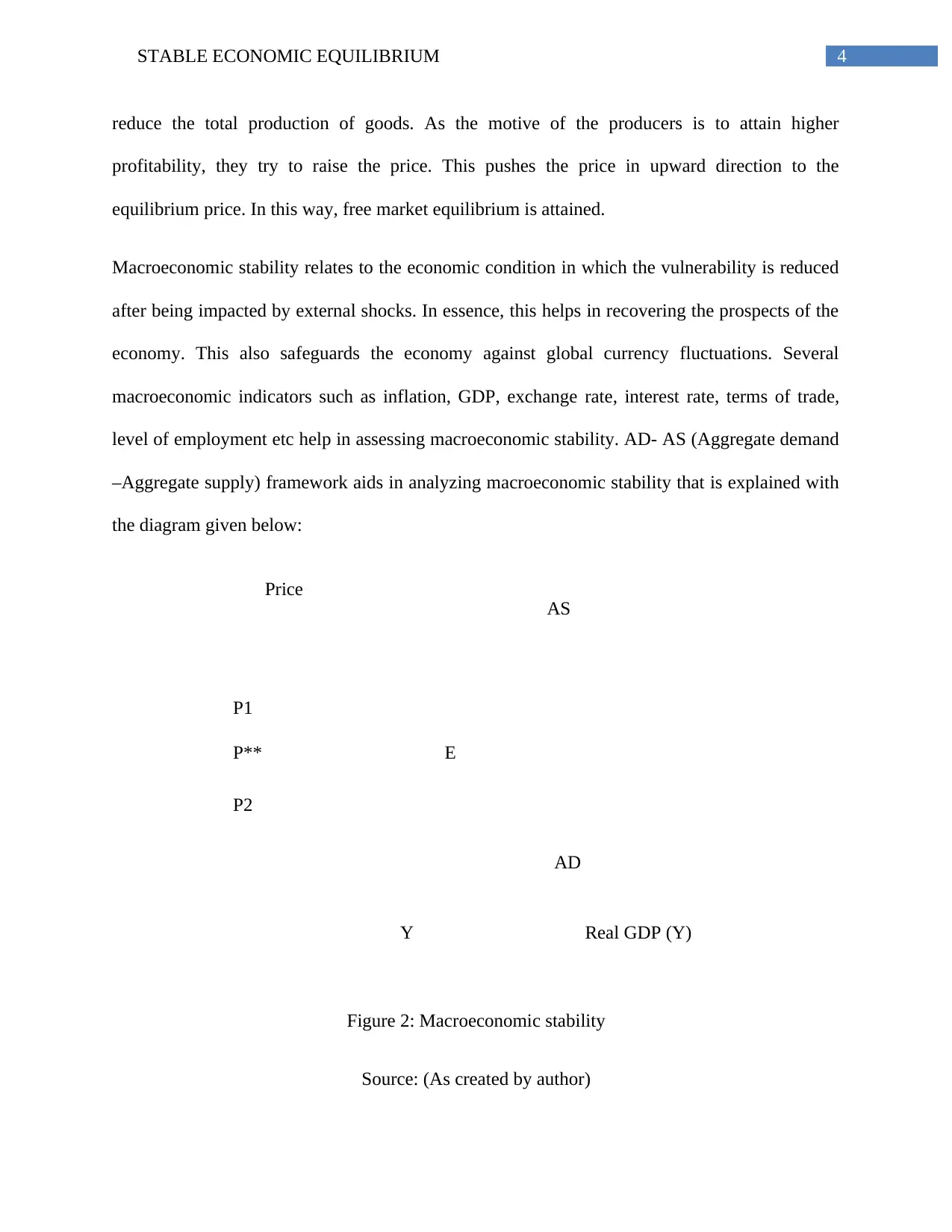
4STABLE ECONOMIC EQUILIBRIUM
AS
AD
Price
Real GDP (Y)
P**
P2
P1
Y
E
reduce the total production of goods. As the motive of the producers is to attain higher
profitability, they try to raise the price. This pushes the price in upward direction to the
equilibrium price. In this way, free market equilibrium is attained.
Macroeconomic stability relates to the economic condition in which the vulnerability is reduced
after being impacted by external shocks. In essence, this helps in recovering the prospects of the
economy. This also safeguards the economy against global currency fluctuations. Several
macroeconomic indicators such as inflation, GDP, exchange rate, interest rate, terms of trade,
level of employment etc help in assessing macroeconomic stability. AD- AS (Aggregate demand
–Aggregate supply) framework aids in analyzing macroeconomic stability that is explained with
the diagram given below:
Figure 2: Macroeconomic stability
Source: (As created by author)
AS
AD
Price
Real GDP (Y)
P**
P2
P1
Y
E
reduce the total production of goods. As the motive of the producers is to attain higher
profitability, they try to raise the price. This pushes the price in upward direction to the
equilibrium price. In this way, free market equilibrium is attained.
Macroeconomic stability relates to the economic condition in which the vulnerability is reduced
after being impacted by external shocks. In essence, this helps in recovering the prospects of the
economy. This also safeguards the economy against global currency fluctuations. Several
macroeconomic indicators such as inflation, GDP, exchange rate, interest rate, terms of trade,
level of employment etc help in assessing macroeconomic stability. AD- AS (Aggregate demand
–Aggregate supply) framework aids in analyzing macroeconomic stability that is explained with
the diagram given below:
Figure 2: Macroeconomic stability
Source: (As created by author)
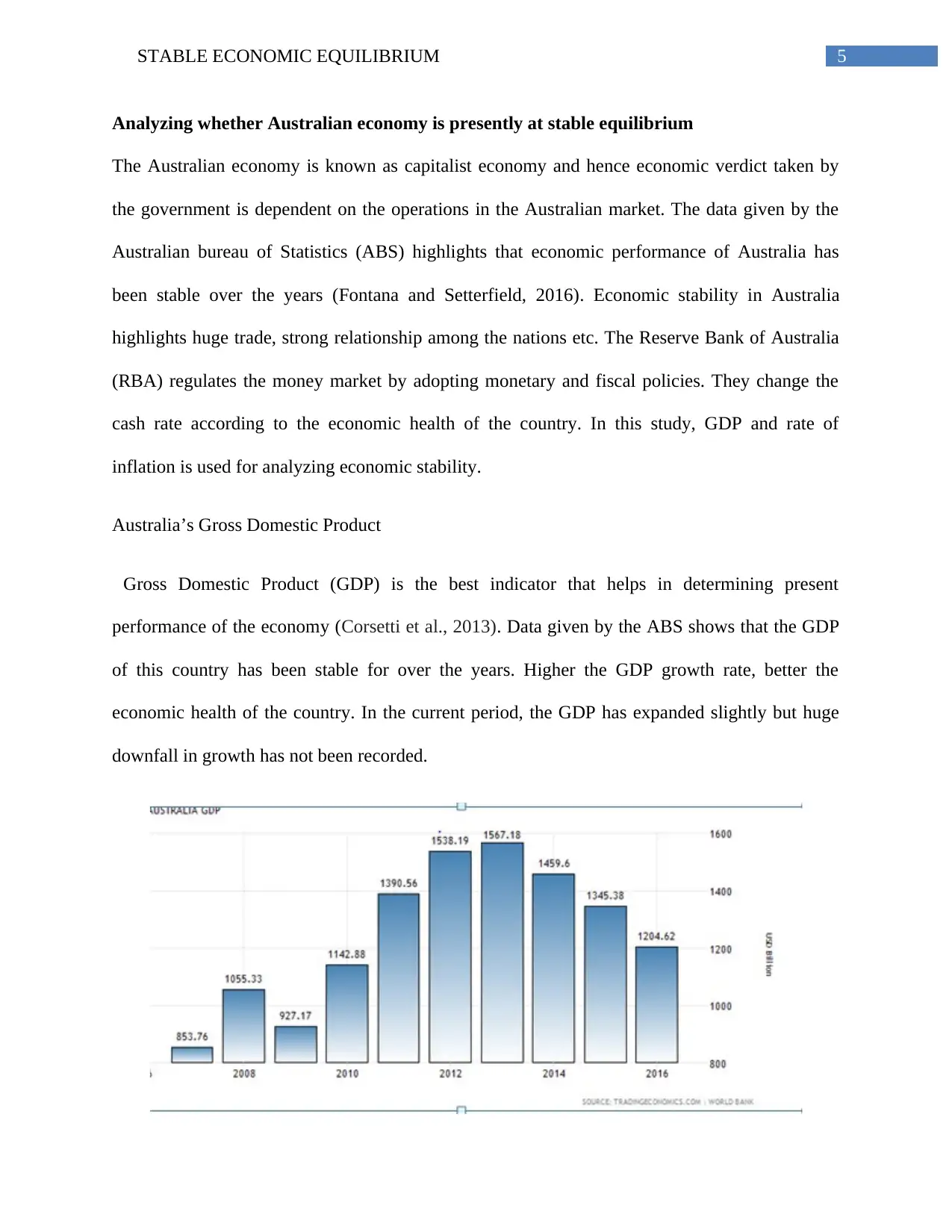
5STABLE ECONOMIC EQUILIBRIUM
Analyzing whether Australian economy is presently at stable equilibrium
The Australian economy is known as capitalist economy and hence economic verdict taken by
the government is dependent on the operations in the Australian market. The data given by the
Australian bureau of Statistics (ABS) highlights that economic performance of Australia has
been stable over the years (Fontana and Setterfield, 2016). Economic stability in Australia
highlights huge trade, strong relationship among the nations etc. The Reserve Bank of Australia
(RBA) regulates the money market by adopting monetary and fiscal policies. They change the
cash rate according to the economic health of the country. In this study, GDP and rate of
inflation is used for analyzing economic stability.
Australia’s Gross Domestic Product
Gross Domestic Product (GDP) is the best indicator that helps in determining present
performance of the economy (Corsetti et al., 2013). Data given by the ABS shows that the GDP
of this country has been stable for over the years. Higher the GDP growth rate, better the
economic health of the country. In the current period, the GDP has expanded slightly but huge
downfall in growth has not been recorded.
Analyzing whether Australian economy is presently at stable equilibrium
The Australian economy is known as capitalist economy and hence economic verdict taken by
the government is dependent on the operations in the Australian market. The data given by the
Australian bureau of Statistics (ABS) highlights that economic performance of Australia has
been stable over the years (Fontana and Setterfield, 2016). Economic stability in Australia
highlights huge trade, strong relationship among the nations etc. The Reserve Bank of Australia
(RBA) regulates the money market by adopting monetary and fiscal policies. They change the
cash rate according to the economic health of the country. In this study, GDP and rate of
inflation is used for analyzing economic stability.
Australia’s Gross Domestic Product
Gross Domestic Product (GDP) is the best indicator that helps in determining present
performance of the economy (Corsetti et al., 2013). Data given by the ABS shows that the GDP
of this country has been stable for over the years. Higher the GDP growth rate, better the
economic health of the country. In the current period, the GDP has expanded slightly but huge
downfall in growth has not been recorded.
⊘ This is a preview!⊘
Do you want full access?
Subscribe today to unlock all pages.

Trusted by 1+ million students worldwide
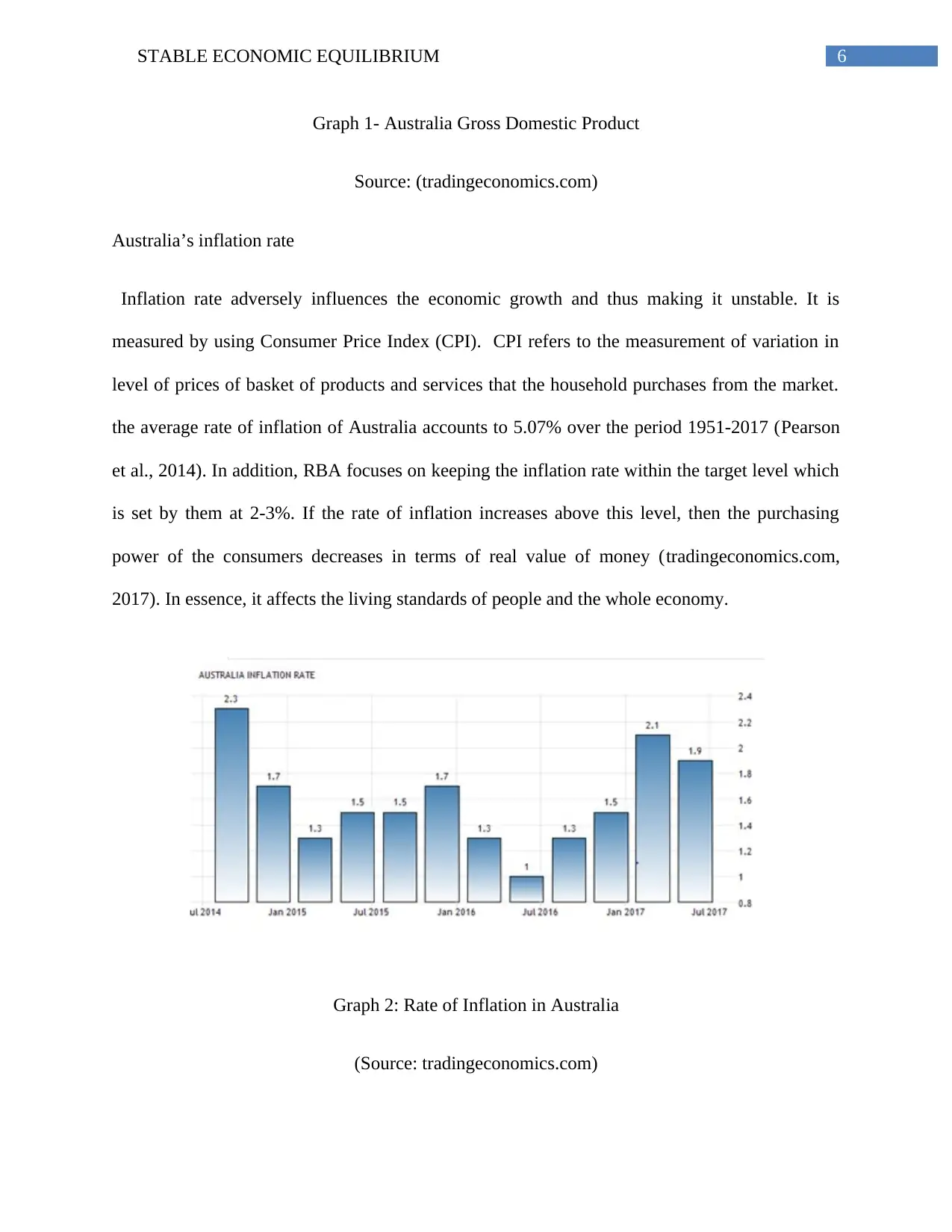
6STABLE ECONOMIC EQUILIBRIUM
Graph 1- Australia Gross Domestic Product
Source: (tradingeconomics.com)
Australia’s inflation rate
Inflation rate adversely influences the economic growth and thus making it unstable. It is
measured by using Consumer Price Index (CPI). CPI refers to the measurement of variation in
level of prices of basket of products and services that the household purchases from the market.
the average rate of inflation of Australia accounts to 5.07% over the period 1951-2017 (Pearson
et al., 2014). In addition, RBA focuses on keeping the inflation rate within the target level which
is set by them at 2-3%. If the rate of inflation increases above this level, then the purchasing
power of the consumers decreases in terms of real value of money (tradingeconomics.com,
2017). In essence, it affects the living standards of people and the whole economy.
Graph 2: Rate of Inflation in Australia
(Source: tradingeconomics.com)
Graph 1- Australia Gross Domestic Product
Source: (tradingeconomics.com)
Australia’s inflation rate
Inflation rate adversely influences the economic growth and thus making it unstable. It is
measured by using Consumer Price Index (CPI). CPI refers to the measurement of variation in
level of prices of basket of products and services that the household purchases from the market.
the average rate of inflation of Australia accounts to 5.07% over the period 1951-2017 (Pearson
et al., 2014). In addition, RBA focuses on keeping the inflation rate within the target level which
is set by them at 2-3%. If the rate of inflation increases above this level, then the purchasing
power of the consumers decreases in terms of real value of money (tradingeconomics.com,
2017). In essence, it affects the living standards of people and the whole economy.
Graph 2: Rate of Inflation in Australia
(Source: tradingeconomics.com)
Paraphrase This Document
Need a fresh take? Get an instant paraphrase of this document with our AI Paraphraser
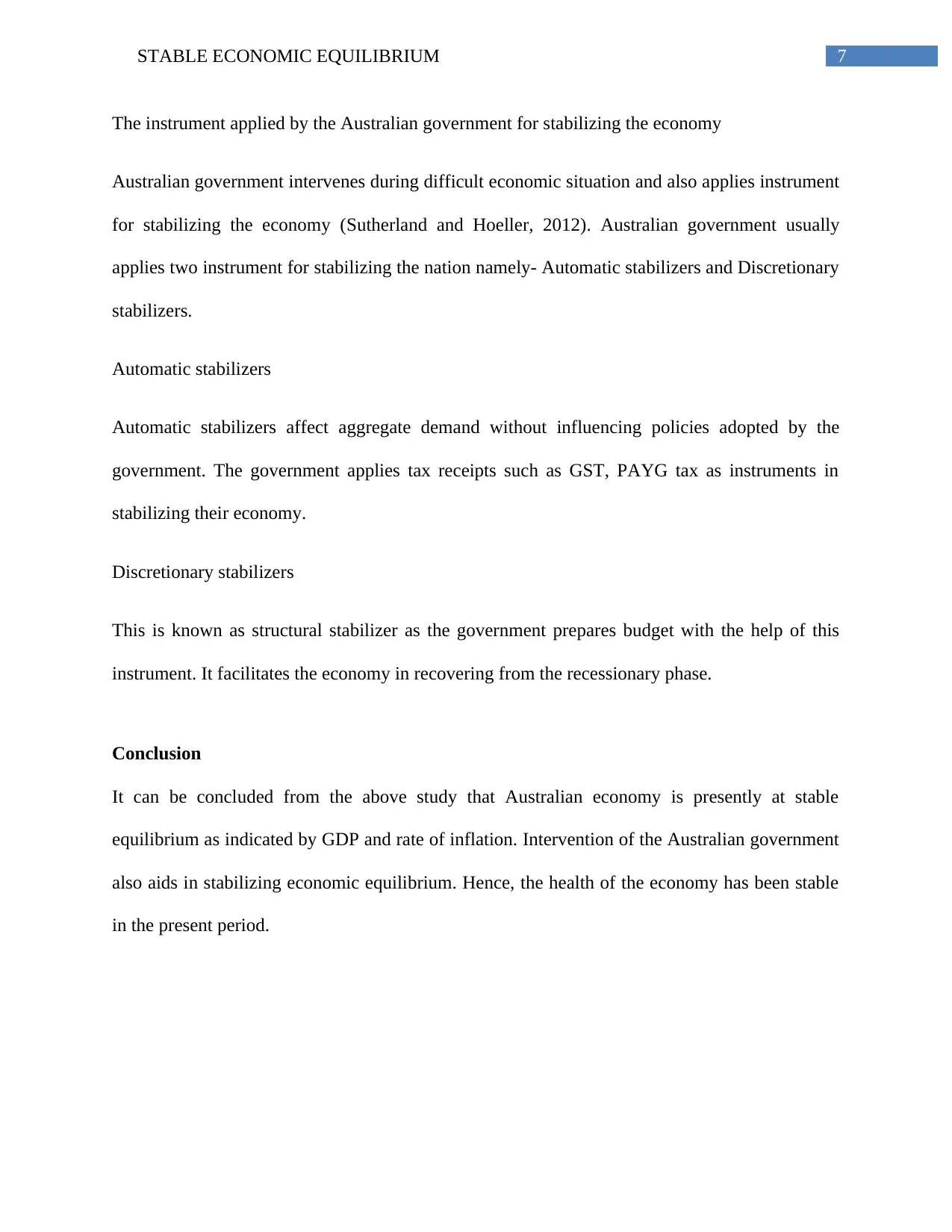
7STABLE ECONOMIC EQUILIBRIUM
The instrument applied by the Australian government for stabilizing the economy
Australian government intervenes during difficult economic situation and also applies instrument
for stabilizing the economy (Sutherland and Hoeller, 2012). Australian government usually
applies two instrument for stabilizing the nation namely- Automatic stabilizers and Discretionary
stabilizers.
Automatic stabilizers
Automatic stabilizers affect aggregate demand without influencing policies adopted by the
government. The government applies tax receipts such as GST, PAYG tax as instruments in
stabilizing their economy.
Discretionary stabilizers
This is known as structural stabilizer as the government prepares budget with the help of this
instrument. It facilitates the economy in recovering from the recessionary phase.
Conclusion
It can be concluded from the above study that Australian economy is presently at stable
equilibrium as indicated by GDP and rate of inflation. Intervention of the Australian government
also aids in stabilizing economic equilibrium. Hence, the health of the economy has been stable
in the present period.
The instrument applied by the Australian government for stabilizing the economy
Australian government intervenes during difficult economic situation and also applies instrument
for stabilizing the economy (Sutherland and Hoeller, 2012). Australian government usually
applies two instrument for stabilizing the nation namely- Automatic stabilizers and Discretionary
stabilizers.
Automatic stabilizers
Automatic stabilizers affect aggregate demand without influencing policies adopted by the
government. The government applies tax receipts such as GST, PAYG tax as instruments in
stabilizing their economy.
Discretionary stabilizers
This is known as structural stabilizer as the government prepares budget with the help of this
instrument. It facilitates the economy in recovering from the recessionary phase.
Conclusion
It can be concluded from the above study that Australian economy is presently at stable
equilibrium as indicated by GDP and rate of inflation. Intervention of the Australian government
also aids in stabilizing economic equilibrium. Hence, the health of the economy has been stable
in the present period.
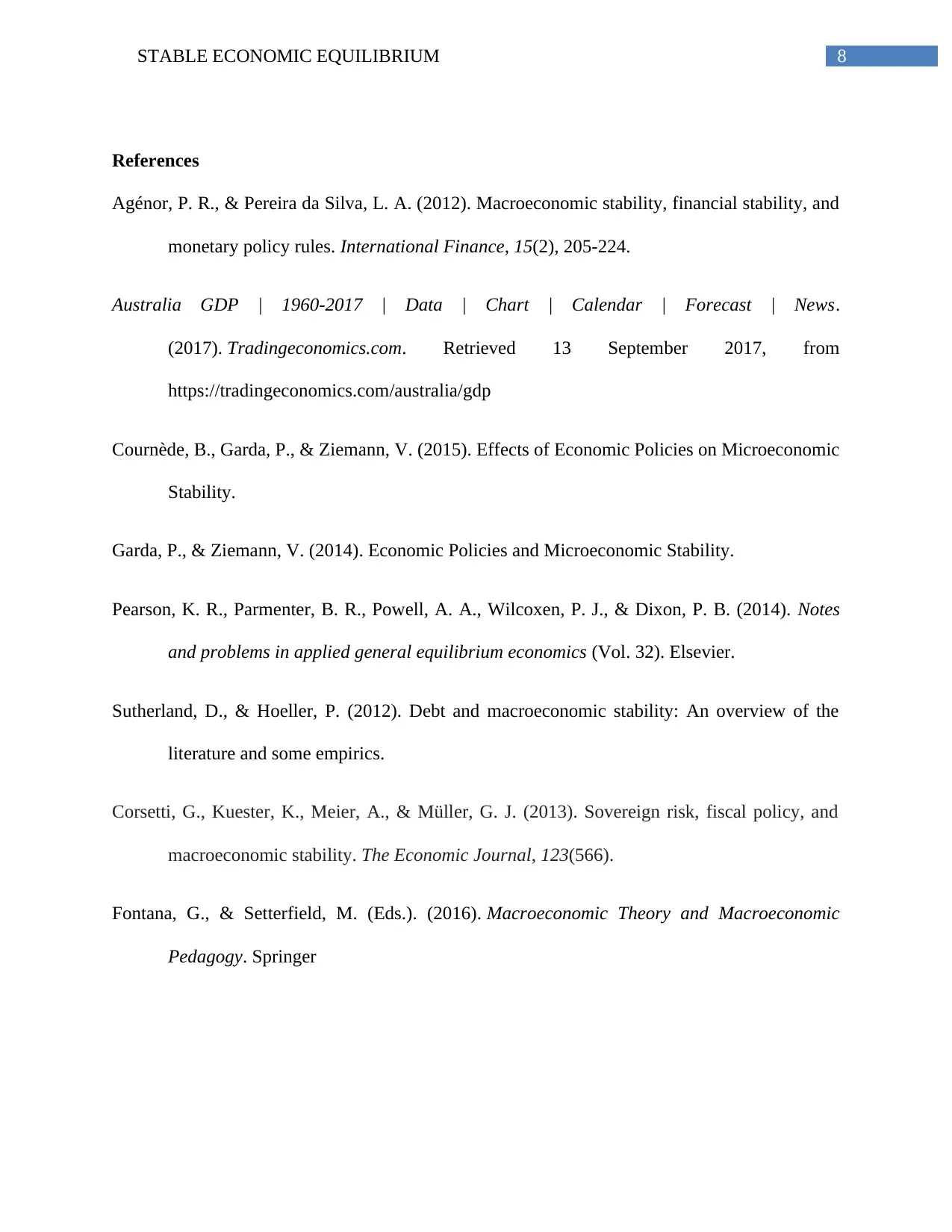
8STABLE ECONOMIC EQUILIBRIUM
References
Agénor, P. R., & Pereira da Silva, L. A. (2012). Macroeconomic stability, financial stability, and
monetary policy rules. International Finance, 15(2), 205-224.
Australia GDP | 1960-2017 | Data | Chart | Calendar | Forecast | News.
(2017). Tradingeconomics.com. Retrieved 13 September 2017, from
https://tradingeconomics.com/australia/gdp
Cournède, B., Garda, P., & Ziemann, V. (2015). Effects of Economic Policies on Microeconomic
Stability.
Garda, P., & Ziemann, V. (2014). Economic Policies and Microeconomic Stability.
Pearson, K. R., Parmenter, B. R., Powell, A. A., Wilcoxen, P. J., & Dixon, P. B. (2014). Notes
and problems in applied general equilibrium economics (Vol. 32). Elsevier.
Sutherland, D., & Hoeller, P. (2012). Debt and macroeconomic stability: An overview of the
literature and some empirics.
Corsetti, G., Kuester, K., Meier, A., & Müller, G. J. (2013). Sovereign risk, fiscal policy, and
macroeconomic stability. The Economic Journal, 123(566).
Fontana, G., & Setterfield, M. (Eds.). (2016). Macroeconomic Theory and Macroeconomic
Pedagogy. Springer
References
Agénor, P. R., & Pereira da Silva, L. A. (2012). Macroeconomic stability, financial stability, and
monetary policy rules. International Finance, 15(2), 205-224.
Australia GDP | 1960-2017 | Data | Chart | Calendar | Forecast | News.
(2017). Tradingeconomics.com. Retrieved 13 September 2017, from
https://tradingeconomics.com/australia/gdp
Cournède, B., Garda, P., & Ziemann, V. (2015). Effects of Economic Policies on Microeconomic
Stability.
Garda, P., & Ziemann, V. (2014). Economic Policies and Microeconomic Stability.
Pearson, K. R., Parmenter, B. R., Powell, A. A., Wilcoxen, P. J., & Dixon, P. B. (2014). Notes
and problems in applied general equilibrium economics (Vol. 32). Elsevier.
Sutherland, D., & Hoeller, P. (2012). Debt and macroeconomic stability: An overview of the
literature and some empirics.
Corsetti, G., Kuester, K., Meier, A., & Müller, G. J. (2013). Sovereign risk, fiscal policy, and
macroeconomic stability. The Economic Journal, 123(566).
Fontana, G., & Setterfield, M. (Eds.). (2016). Macroeconomic Theory and Macroeconomic
Pedagogy. Springer
⊘ This is a preview!⊘
Do you want full access?
Subscribe today to unlock all pages.

Trusted by 1+ million students worldwide
1 out of 9
Related Documents
Your All-in-One AI-Powered Toolkit for Academic Success.
+13062052269
info@desklib.com
Available 24*7 on WhatsApp / Email
![[object Object]](/_next/static/media/star-bottom.7253800d.svg)
Unlock your academic potential
Copyright © 2020–2025 A2Z Services. All Rights Reserved. Developed and managed by ZUCOL.





